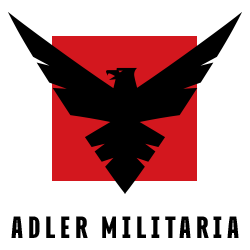Showing 217–225 of 1093 resultsSorted by latest
-

WWII German Navy – Kriegsmarine M40 – Side Cap – Formed Issued – Size 57 – Original Paris Made (Offer Accepted)
Made by Chapeliere Parisienne Paris, Size 57. Really nice cap here with form, the owner has added fine thread to hold it into form when in wear. This one has character.
-

WWII German Anti-Aircraft Flak Battle Badge – Flak-Kampfabzeichen der Luftwaffe – GWL – Wegerhoff – Original
Nice badge in Zinc by GWL (Wgerhoff) with the riveted Eagle. Condition: Hard to upgrade that one with such a nice finish/wash still intact. Anti-Aircraft Flak Battle Badge (German: Flak-Kampfabzeichen der Luftwaffe) was a World War II military decoration of Nazi Germany. It was instituted on 10 January 1941 by Hermann Göring in his capacity as the Commander in Chief of the Luftwaffe. The badge was awarded to servicemen of the Flak artillery who distinguished themselves in action against enemy aerial or ground attacks. Designed by Wilhelm Ernst Peekhaus, the badge was of single piece construction with a pin back and clasp. It was made in one grade; it had a Luftwaffe eagle at the top, and an oak leaf wreath around the outside rim. In the middle was an 88 mm flak gun with the barrel facing upwards to the right. The badge was worn on the lower part of the left breast pocket of the service tunic, underneath the 1st class Iron Cross if awarded. Criteria It was awarded after the accumulation of 16 points or could also be awarded outside of the points system for an act of merit or bravery in the performance of air defense duties. If the candidates’ battery brought down an enemy aircraft then the crew members were awarded four points. If two batteries were involved then each battery received two points.[2] Both officers and crews were eligible for the badge. The commanding officer for an anti-aircraft unit was eligible for the badge once half of his men also qualified for the badge. The award was also available to searchlight crews and sound-locator crews. Searchlight and sound-locator crews which assisted in the action by detection of aircraft could be awarded one point each. The German Army had a similar badge, however, earning points towards it were only awarded for the downing of aircraft and not for ground targets. Prior to the introduction of the Ground Assault Badge of the Luftwaffe, this badge could be awarded to a serviceman for the participation in three separate combat operations against tanks, bunkers or ships.
-

WWII German Luftwaffe Ground Assault Badge – Erdkampfabzeichen der Luftwaffe – Late War Arno Wallpach -Original (Sold)
A nice unmarked version made by Anro Wallpach Condition: No repairs, nice amount of the grey finish on the clouds. The Ground Assault Badge of the Luftwaffe (German: Erdkampfabzeichen der Luftwaffe) was a World War II German military decoration awarded to Luftwaffe personnel for achievement in ground combat. It was instituted on 31 March 1942 by the commander-in-chief (Oberbefehlshaber der Luftwaffe) Hermann Göring. The badge, designed by the graphic and textile artist Sigmund von Weech (1888-1982), features an oak leaf wreath with at its apex a Luftwaffe eagle, grasping a swastika, flying above a storm cloud, from which a centered positioned lightning bolt strikes trough ground. The general criteria for its presentation was the participation in three separate combat operations on separate days. Luftwaffe soldiers who had already been awarded combat recognition badges of the Heer (German Army), such as the General Assault Badge or the Infantry Assault Badge, were required to exchange their badges for the Ground Assault Badge of the Luftwaffe. As the war progressed it became necessary to further distinguish those soldiers who had already exceeded the awarding criteria. To accomplish this distinction, Göring instituted four numbered grades on 10 November 1944 based on the number of combat operations. The new badge was changed at its base to incorporate the operations number marking each new grade. 2nd grade (II. Stufe) for 25 eligible operations 3rd grade (III. Stufe) for 50 eligible operations 4th grade (IV. Stufe) for 75 eligible operations 5th grade (V. Stufe) for 100 eligible operations
-
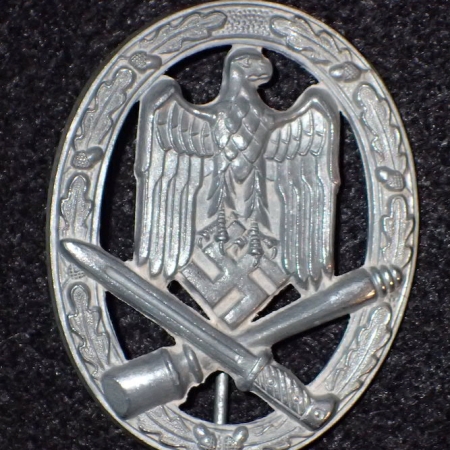
WWII German Wehrmacht / Waffen SS – General Assault Badge – Allgemeines Sturmabzeichen – Assmann Mould 4 – MINT – Original SOLD
Here we have a nice Assmann & Sohn Mould 4 Condition – Hard to upgrade that condition, 95% finish and tooling marks visible. The General Assault Badge (German: Allgemeines Sturmabzeichen) was a military decoration awarded during World War II to personnel of the German Army, Waffen-SS and Ordnungspolizei (order police) who supported an infantry attack but were not part of specific infantry units and therefore did not qualify for the Infantry Assault Badge. It was instituted by General Walther von Brauchitsch on 1 June 1940. Design The decoration, designed by the Berlin-based firm of Wilhelm Ernst Peekhaus, was an oval disk that measured 5.3 cm (2.1 in) by 4.2 cm (1.7 in), with a depth of .6 cm (0.2 in). A wreath of five oak leaves runs around the circumference on each side of the medal with a pair of acorns at the base. Inside the wreath is a large Wehrmacht-style eagle with folded wings grasping a swastika which itself surmounts a crossed bayonet and stick grenade. The medal was held in place on the uniform with a pin and catch,[2] and was worn on the left chest pocket. From 22 June 1943, further classes were created, these bearing a small plate at the base with either 25, 50, 75 or 100 to recognise those soldiers who had taken part in numerous attacks. These were known as grades II through V, accordingly. On the Class IV and Class V badges the oak leaves which run around the circumference on each side of the medal, along with the bayonet and hand grenade, were larger in size – 5.7 cm (2.2 in) by 4.8 cm (1.9 in). Further the wreath was gold in color.[2] Only one badge, the highest level received, was worn. Nazi-era awards were initially banned by the post-war Federal Republic of Germany. In 1957 many World War II military decorations, including the General Assault Badge, were reauthorised for wear by qualifying veterans. With display of Nazi symbols banned, the badge was re-designed by removing the swastika, with members of the Bundeswehr wearing the badge on the ribbon bar, represented by a small replica of the award on a field grey ribbon. Criteria for award The medal was originally designed for presentation to combat engineers, as well as members of the artillery, anti-aircraft and anti-tank who supported infantry units in combat. It could also be awarded to medical personnel attending to battlefield casualties in “close combat conditions”.[1] Prior to the introduction of the Tank Destruction Badge in March 1942, the General Assault Badge could be conferred for the single-handed destruction of tanks or armoured vehicles. Other determining factors for award: Ineligibility for the Infantry Assault Badge Participation in three infantry or armored attacks on three different days; or Participation in three infantry or armored indirect assaults on three different days.
-
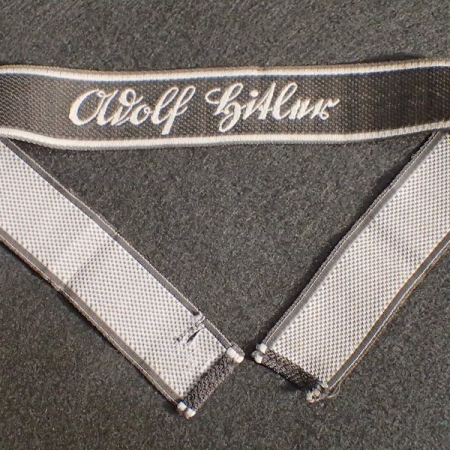
WWII German Waffen SS Cuff Title – Adolf Hitler – Leibstandarte – Bevo Wuppertal – Original Full length – Rare (Offer Accepted)
Here we have a nice GI Bring back AH Cuff Title for the Leibstandarte. Worn by members of the SS-Leibstandarte “Adolf Hitler”. Machine-woven. Maker is Bevo Wuppertal Theses seem to be quite hard to find today.
-
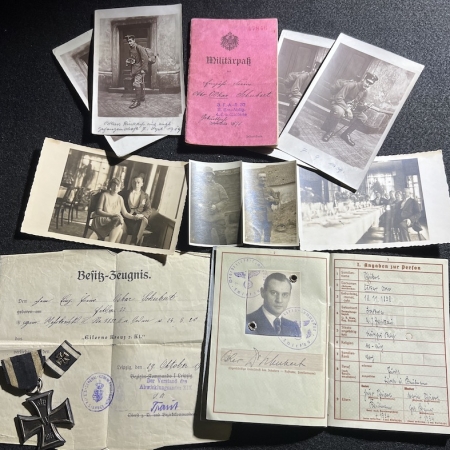
WWI & WWII German Imperial Army Grouping – Oskar Schubert – Iron Cross in 1920 (Rare) – Fought in Eastern Front & Western Front – Captured in Messins June 1917 By British Army – Rare (Offer Accepted)
An incredible Grouping to Oskar Schubert, who fought in WWI in the German Imperial Army in 1917 – on the eastern Front shortly before his transfer to the Western Front. He served with the Feld Artillerie Regiment 32. He was awarded the Iron Cross Second Class in October of 1920, this is a first for me to see such an interwar award of the Iron Cross. He served with the Feld Artillerie Regiment 32. During WWII he was issued a Wehrpass, although only signs of being held in reserve. During WWII he worked as a Lawyer. Nice photos noted , return home after release 1919. An interesting and rather unusual Iron Cross Grouping.
-
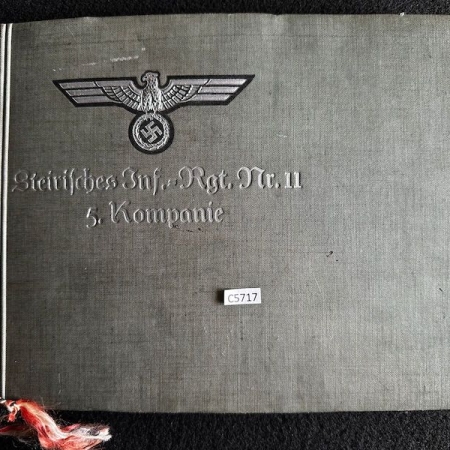
WWII German Wehrmacht Photo Album – Steirisches Infanterie Regiment Nr 11 – Panzer Picture – BMW Side Cars – Awards – Portraits – Rare
An interesting album, some loose photos.
-
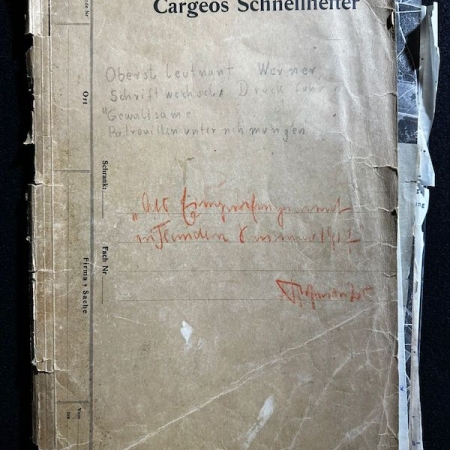
WWI – Reichswehr – Generals Secret Marked Folder – Oberst Werner (RK) – Violent Patrol Operations Flanders 1917 – Reichsarchiv Berlin – Hans von Grieffenberg (RK) Rare
The file was prepared by Oberleutnant Werner for a German Ary Book he worked on. He studied the Battles carefully and published. Werner who signed this folder multiple times, his picture on Lexicon Der Wehrmacht. Paul-Hermann Werner joined the Imperial Army as a soldier around 1912. He came to Railway Regiment No. 2. He was promoted to lieutenant with a commission dated August 20, 1912. Even before the start of the First World War in the summer of 1914, he was still a company officer in Railway Regiment No. 2. On December 18, 1917, he was promoted to first lieutenant. In the First World War he was not only wounded several times, which was reflected in the awarding of the wounded badge in silver. In the First World War, in addition to the Knight’s Cross of the Royal Prussian House Order of Hohenzollern with swords and both Iron Crosses, he was also awarded other awards. After the war he was accepted into the Imperial Army as a first lieutenant with his old seniority. In the 200,000-man transitional army in the spring of 1920, he was part of the Reichswehr Infantry Regiment 3. When the 100,000-man army of the Reichswehr was formed, he was assigned to the 5th (Prussian) Infantry Regiment as a company officer. On October 1, 1921, he was transferred to the 5th (Prussian) Cavalry Regiment as a squadron officer. He was probably assigned to the staff of the 2nd Division of the Reichswehr in Stettin for two years to train as an assistant commander. From the spring of 1924 at the latest he belonged to the 4th (MG.) Company of the 5th (Prussian) Infantry Regiment in Stettin. In 1924/25 he was transferred to Schwerin (Mecklenburg) as a company officer in the 2nd company of the 2nd (Prussian) motor vehicle department. In 1925/26 he was transferred to the staff of the 2nd (Prussian) Motor Vehicle Department in Stettin. On February 1, 1926 he was promoted to captain. In 1927/28 he was appointed head of the 2nd company of the 2nd (Prussian) motor vehicle department in Schwerin (Mecklenburg). He then held this position for several years. In the spring of 1931 he was transferred to the Reichswehr Ministry (RWM) in Berlin. There he was employed as a clerk in the inspection of the traffic troops (In 6). For the next few years he was deployed there to the staff of the motor force under Major General Lutz. After the expansion of the Reichwehr into the Wehrmacht, he was promoted to lieutenant colonel on January 1, 1937. As such, he was then deployed as commander of the anti-tank division 20 in Hamburg. In the fall of 1938 he took over the position of commander of the anti-tank troops X in Hamburg. After the Polish campaign, he became a colonel and commander of the 31st Panzer Regiment of the 5th Panzer Division. He then led his unit with particular skill in the western campaign in the spring of 1940. He always led the regiment, which at that time stormed the Loretto Heights north of Arras, “from the front”. For his outstanding achievements he was awarded the Knight’s Cross of the Iron Cross on June 3, 1940. In the second part of the western campaign, he forced his tanks to cross the Somme near Amiens. He captured Ruon and closed the pocket near St. Valéry with the entire 7th Panzer Division. After a forced march of 360 kilometers in two days, he was the first officer of the Wehrmacht to reach the military port of Brest on June 19, 1940. In the course of a swimming accident in the Atlantic, Colonel Werner died of a heart attack just a few days later on June 30, 1940. After the funeral service took place in the Hamburg Hanseatic Barracks on July 5, 1940, he was buried the following day in camps near Schwerin. The Pictures in the folder are ordered and show the frontline, they are marked Secret (Geheim) and made by the Bildstelle der 2 Division. Area are – Reserve Infanterie Regiment 229 Positions on the 31st of July 1917 in Flanders. (Area – Langermark – Poelkapelle). For Which the Commander of the unit was awarded the Pour le Merit. One letter from an Oberlt in the K.A.2 sends Generalleutnant a.d Schwarte (Berlin, Charlottenburg). There is a signature of Generalleutnant a.d Schwarte More about Schwarte: Schwarte had been an officer in the Prussian Army since October 14, 1880. Before his military career, he worked as a teacher at the War Academy in Berlin from 1902 and as a department head in the General Staff from 1906. From August 15, 1912 to January 26, 1913, Schwarte was commander of the 4th Upper Silesian Infantry Regiment No. 63 in Opole. He was then transferred to Wesel as commander of the 79th Infantry Brigade and was promoted to major general. At the beginning of the First World War, he led his brigade, consisting of Infantry Regiments No. 56 and 57, as part of the 14th Division on the northern Western Front. Schwarte took part in the battles of St. Quentin and the Marne. From November 23, 1914 to February 13, 1915 he commanded the 17th Reserve Division and since February 16, 1915 the 10th Infantry Division. In this capacity, Schwarte was promoted to lieutenant general on June 6, 1916 and was awarded the Order of the Red Eagle, 2nd class, with oak leaves and swords in December 1916. On April 30, 1917, Schwarte was recalled.[5] From 1919, Schwarte was editor of Wehr und Waffen. Technology in the World War. He was also the author and editor of a large number of military history books and essays. The historian Ulrich Herbert places Schwarte alongside Friedrich von Bernhardi, Joachim von Stülpnagel and Kurt Hesse among the four military men or military writers whose interpretation of the First World War was crucial for laying the foundations of the political and ideological formation of National Socialist Germany: “the war was…
-
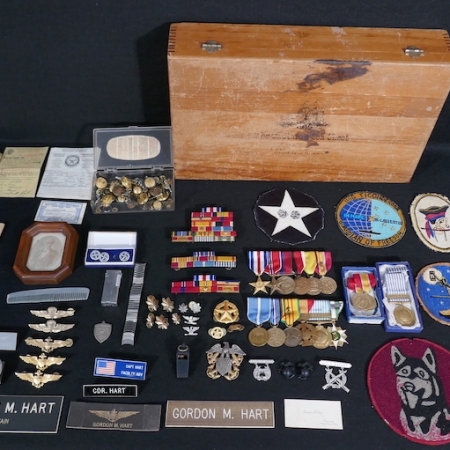
WWII / Korea / Vietnam War Grouping – Captain Gordon McAllister Hart – Large Medal Bar – Silver Star & Bronze Star with V – Test Piot – Marine Corps – Rare———————————————————————–
Capt. Hart had been a resident of Chattahoochee since retiring from the Navy in 1973. A native of Cambridge, Mass., he attended Northeastern University from 1937 to 1941 and George Washington University from 1966 to 1967, where he received his Bachelor of Science in political science. He was married to the former Emily Swearingen of Pine Hill, Ala. He was a Mason belonging to the Indian Wells Valley Lodge in Inyokern, Calif., and was a longtime board member at Chattahoochee First United Methodist Church. Capt. Hart, a World War II veteran, entered the U.S. Navy at Pensacola in January 1942, following Pearl Harbor and received his Navy Wings of Gold in 1943. Following a tour as a flight instructor, he joined Night Fighter Squadron 55 embarked on the USS Enterprise (CV-6) in 1945, and later, Night Fighter Squadron 90 at the Naval Air Station in Key West. During his 31-year career in the Navy he was ordnance test pilot at the Naval Ordnance Test Station in Inyokern; attended Empire Test Pilot School in Farnbrough, England; was the executive officer of the first Cougar squadron to be deployed, Fighter Squadron 24, embarked on the USS Yorktown (CVA-10); and headed the Navy’s Air Traffic Control Office in the Office of the Chief of Naval Operations. He was operations officer of Carrier Air Wing Eleven, commanding officer of Attack Squadron 94, of Carrier Wing Nine embarked on USS Ranger (CVA-61), and operations and executive officer of USS Ticonderoga (CVA-14). He attended and was on the staff at the NATO Defense College, in Rome, Italy and retired in 1973 following his tour as the executive officer of the Naval Air Engineering Center in Philadelphia. He passed away in 2005. All items pictured are part of the sale. (Last two photos are reference only). Final Comments: Some incredible history there, sadly we did not find the exploits in detail of Captain Hart although we are happy to offer this on for further study. It is possible at the National Archives there is more information to find out about his career. Some of the patches are incredibly rare, especially the 55th Night Fighter Jacket Patch. Name Gordon McAllister Hart Gender Male Birth Date 14 Nov 1919 Death Date 9 Feb 2005 Cause of Death Natural SSN 032078136 Enlistment Branch NAVY Enlistment Date 26 Feb 1942 Discharge Date 30 Jun 1973
